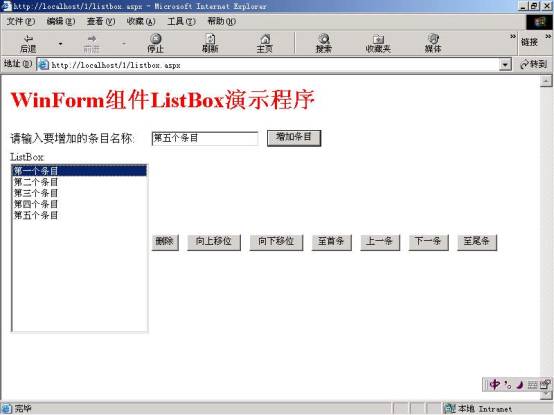ListBox組件是一個程序設計中經常使用到的組件
在Visual C#和Visual Basic
Net程序中使用這個組件
必須要在程序中導入
Net FrameWork SDK中名稱空間System
Windows
Forms
因為在System
Windows
Forms名稱空間中定義了這個組件
在ASP
NET的Web頁面中
ListBox組件是作為一個服務器端組件的形式出現的
所謂服務器端組件就是這些組件是在服務器端存在的
本文就是來介紹ListBox組件在ASP
NET的Web頁面中的具體使用和操作方法
一. 如何在ASPNET頁面中定義一個ListBox組件 在ASP
NET頁面中創建一個ListBox組件的語法如下
<asp:ListBox Id =
MyListBox
runat =
server
>
<asp:ListItem Value =
>第一個條目</asp:ListItem >
<asp:ListItem Value =
>第二個條目</asp:ListItem >
注釋
這裡還可以加入類似上面的若干條目
</asp:ListBox >
在Web頁面中執行上面的語句就可以產生一個名稱為
MyListBox
包含若干條目的ListBox組件
二. ListBox組件中常用的屬性 我們通過以下表格來說明ListBox組件的一些常用的屬性
屬性名稱
屬性代表的意義
SelectionMode
組件中條目的選擇的類型即:多選
單選
Single
Multiple
Rows
此組件顯示總共多少行
Selected
檢測條目十分被選中
SelectedItem
返回的類型是ListItem
獲得組件中被選擇的條目
Count
組件中條目的總數
SelectedIndex
組件中被選擇的條目的索引值
Items
泛指組件中所有的條目
每一個條目的類型都是ListItem
三. 通過一個例子來掌握ListBox組件在ASPNET頁面中的具體用法
在下面介紹ListBox組件在ASP
NET中的使用方法的時候
程序采用的程序設計語言是Visual C#
(
)
如何在ListBox組件添加新的條目
通過以下語句就可以在名稱為lstItem的ListBox組件中增加一個名稱為
Sample
的條目
lstItem
Items
Add ( new ListItem (
Sample
) )
(
)
如何在ListBox組件中刪除指定的條目
下列語句就是刪除名稱為lstItem的ListBox組件中的選定的一個條目
lstItem
Items
Remove ( lstItem
SelectedItem )
(
)
如何在組件中移動指向條目的指針
移動條目的指針主要有四種方式
至首條目
至尾條目
下一條
上一條
在程序設計中主要是通過操作組件的Count和SelectedIndex屬性來實現以上四種方式的
以下就是具體實現這四種方式的程序代碼
//按鈕
至首條
事件處理程序
if ( sender == First )
{
if ( lstItem
Items
Count >
)
{
lstItem
SelectedIndex =
;
}
}
//按鈕
至尾條
事件處理程序
if ( sender == Last )
{
if ( lstItem
Items
Count >
)
{
lstItem
SelectedIndex = lstItem
Items
Count
;
}
}
//按鈕
上一條
事件處理程序
if ( sender == Prev )
{
if ( lstItem
SelectedIndex >
)
{
lstItem
SelectedIndex = lstItem
SelectedIndex
;
}
}
//按鈕
下一條
事件處理程序
if ( sender == Next )
{
if ( lstItem
SelectedIndex < lstItem
Items
Count
)
{
lstItem
SelectedIndex = lstItem
SelectedIndex +
;
} }
(
)
如何實現組件中的指定條目的移位
移位包括二種
其一是向上移位
其二是向下移位
程序中具體的實現思路是
創建一個ListItem對象
並把要移位指定的條目中的內容先暫放在此新建的這個對象中
如果選定的是向上移位
就把當前選定的條目的上一個條目的值賦值給當前選定的條目
然後把剛才新建的對象的值
再賦值給選定條目的上一個條目
完成條目的向上移位操作
對於向下移位
可以仿效上面的做法
但和上面做法的主要區別在於不是選定條目的上一個條目了
而是選定條目的下一個條目
下列語句就是就是實現這種思路的具體的程序代碼
//按鈕向上移位和向下移位事件處理程序
if ( ( sender == Up && lstItem SelectedIndex > ) ||
( sender ==
Down && lstItem SelectedIndex < lstItem Items Count ) )
{
int offset ;
if ( sender == Up )
{
offset = ;
}
else
{
offset = ;
}
ListItem lstTemp = new ListItem ( lstItem SelectedItem Text
lstItem SelectedItem Value ) ;
lstItem Items [ lstItemSelectedIndex ] Text =
lstItem Items [ lstItem SelectedIndex + offset ] Text ;
lstItem Items [ lstItem SelectedIndex ] Value =
lstItem Items [ lstItem SelectedIndex + offset ] Value ;
lstItem Items [ lstItem SelectedIndex + offset ] Text =
lstTemp Text ;
lstItem Items [ lstItem SelectedIndex + offset ] Value =
lstTemp Value ;
lstItem SelectedIndex = lstItem SelectedIndex + offset ;
}
四. 本文中源程序代碼(listbox
aspx)和執行的界面
下圖是執行了下列源程序代碼(listbox
aspx)後
生成的界面
 .NET編程免費提供,內容來源於互聯網,本文歸原作者所有。
.NET編程免費提供,內容來源於互聯網,本文歸原作者所有。
 .NET編程免費提供,內容來源於互聯網,本文歸原作者所有。
.NET編程免費提供,內容來源於互聯網,本文歸原作者所有。
